SAVIOUR OR SIREN?
The promises and pitfalls of Karoo agave
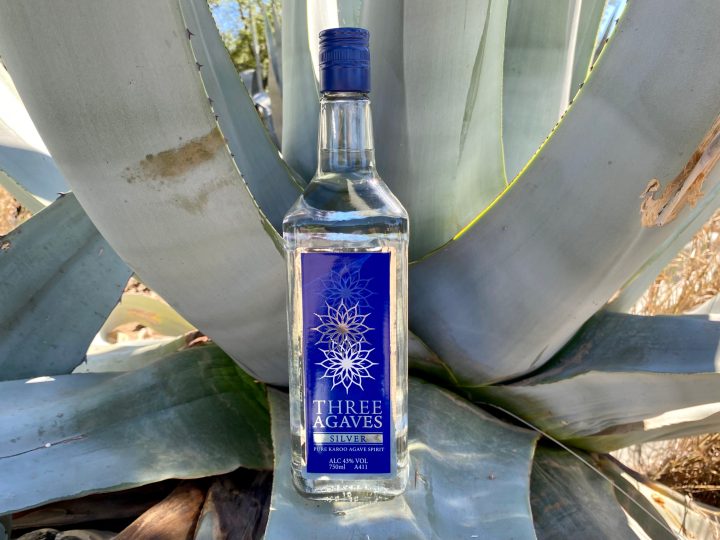
Secreted away at the heart of this strange yet alluring plant is a trove of carbohydrates that can be alchemised into the spirits of Tequila and Mescal.
The author supports the Mother Soup Project, a Woodstock Brewery charity that feeds 21,000 hungry Capetonians soup a day using brewery equipment. Please assist the team here.
It’s a tale as old as time. An enticing creature of the sea seduces men with lyrical promises of rapture, knowledge or power, usually leading them to catastrophe. Except that while the siren of the Karoo may have the tint of the Atlantic, she’s not a watery being. Quite the opposite, in fact; as with her spikey tendrils and tough skin, she’s built for withstanding the desert.
The temptress I’m talking about is agave, a large plant with sharp, sword-like leaves that looks much like an aloe. That may not sound very sexy, but secreted away at the heart of this strange yet alluring plant is a trove of carbohydrates that can be alchemised into the spirits of Tequila and Mescal – beloved intoxicants that, aptly, come with a bite.
Now, if you thought said succubus, erm, succulent, was native to Mexico, you’d be right, but – as I discovered on a recent road trip across the country – agave not only magically found its way across the ocean, but naturalised on our shores.
It now not only litters our hills and roadsides, but is actively cultivated by romantics like Tim Murray at Roode Bloem, his family farm just outside Graaff-Reinet. Murray’s interest is indeed in agave spirits, yet this is not its only attraction.
“This is a marvellous plant, a veritable Mexican supermarket. The Aztecs and Mayans used it for countless purposes, from making musical instruments to structural fibre to building materials. One of the Mexican tricks is to take a leaf and [strip it] with the thorns still on, and then you end up with a needle and thread. I actually have a lady in Cape Town now who wants to use the thread to make weaves, instead of plastic!” Murray enthuses.
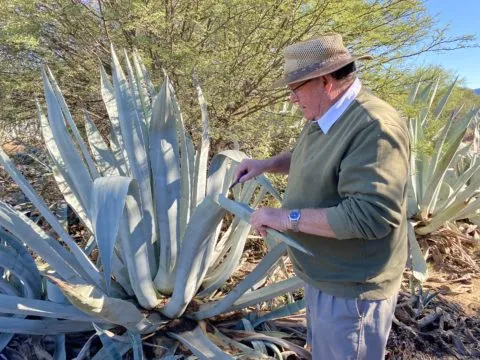
Tim Murray cutting an agave leaf. (Photo: Leah van Deventer)
“It’s antiseptic as well as aseptic, so if you had a cut, you could peel the membrane off and use it as a Band-Aid, and you could use it as old-style cling wrap to keep your food fresh and uncontaminated. You could also eat the heart – the fruit – and drink the inside juices,” he continues.
These ancient people even went so far as to create a sort of beer from the fermented sap, called pulque.
With so many wondrous applications, why have I painted agave out to be a vixen? Well, simply because so many who have tried to capitalise on agave spirits have failed spectacularly.
This is largely due to a lack of appreciation for the incredible patience, resourcefulness, skills and sheer determination required to process the plant.
For starters, it takes anything from 10 to 25 years for it to reach maturity. If left untouched, agave spends the energy stored in its core to push up a single, mast-like stem tipped with flowers. This birthing process exhausts the plant; soon afterwards, it perishes, and its stem comes crashing down.
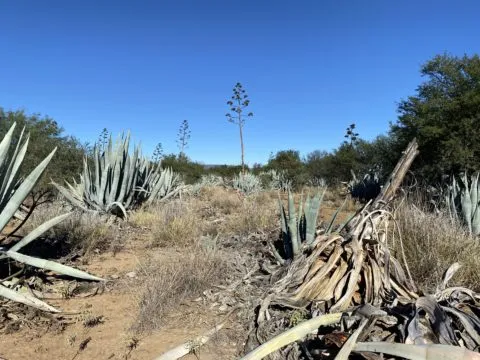
Agave stems and flowers (centre and left) and an expired agave (front right). (Photo: Leah van Deventer)
Naturally, spirit seekers like Murray who are beguiled by the treasure must salvage it before the plant blossoms. However, agave doesn’t part with her hoard easily. An enormous amount of manpower is required to wrestle it from the ground, hack away the toothed foliage and then physically lift and transport the heavy centre – or piña – which weighs in at 35 to 90kg.
… And that’s just the beginning. The pinã still needs to be cooked, ground, fermented and distilled to create agave spirits.
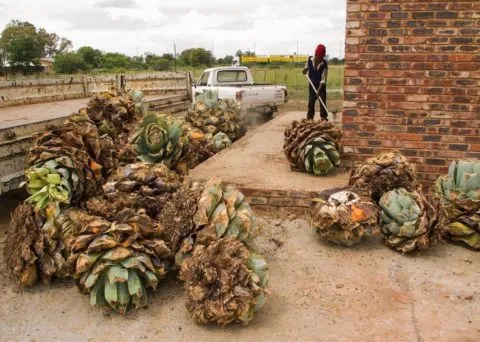
Piñas arriving at Schoonspruit Distillers in Ventersdorp. (Photo: Supplied)
Indeed, Murray may well be the only man in the land who – at the risk of mixing mythologies – has flown close to the sun without plummeting to his doom. His ancestors, though, have certainly had their fair share of ups and downs.
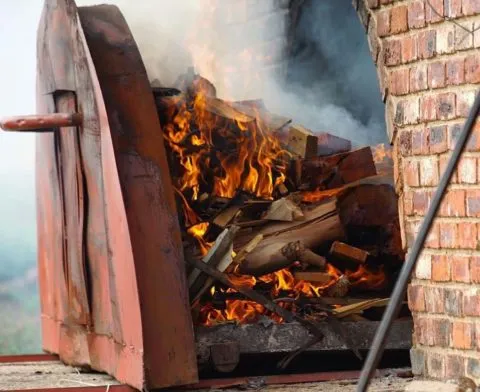
The oven at Schoonspruit Distillers gets fired up. (Photo: Supplied)
The Murrays have been growing agave in Graaff-Reinet for five generations, having moved into the region to fill the void left by the Voortrekkers when they departed on their godless quest beyond the Orange River.
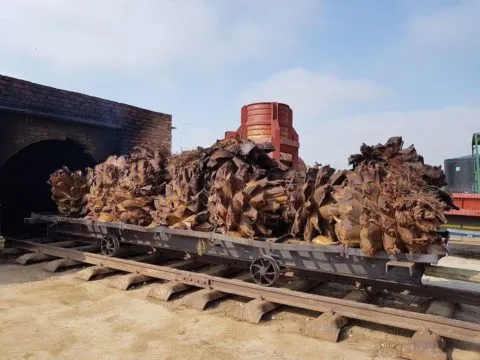
Cooked piñas coming out of the oven at Schoonspruit Distillers. (Photo: Supplied)
“Our family folklore story is that one of the Rubidge children from the district was at school or on a visit down to the Eastern Cape Wild Coast, near the mouth of the Fish River. She spotted some agave growing there, and noticed that they were being eaten by goats and sheep during the drought,” says Murray.
“She realised that there was merit in this plant, so she put three little suckers into her saddle bag, and came back to her [aunt Eleanor Dixie Southey’s] farm, Bloemhof, and planted the first three little plants there,” he expands.
This was likely in the 1830s or 1840s.
A commercial opportunity arose with the arrival of the ostrich boom in the 1860s, as agave could be used as fodder for the flightless birds. So the plants were distributed among the Rubidges, Southeys and Murrays, who were all intermarried, and they began creating plantations.
“There was a lot of money to be made out of ostrich feathers. Then, at least twice, there was a depression and the ostrich price collapsed. The main reason at the end was the advent of the motorcar, when all of a sudden it wasn’t so easy to have a plume in your hat!” chuckles Murray.
By 1914, most of the ostrich farmers were bankrupt, leaving our agave-farming friends with plenty of produce but no market. So, for the next few generations, they used their plantations for daily fodder, veld reclamation and drought relief; in fact, it proved so effective for the latter that at one point the Department of Agriculture insisted all Karoo farmers plant agave for drought reserves.
“The only animal that doesn’t eat it is the horse. But on this farm, you can see from all the dung, there are a lot of bush pigs. They’re after the babies, the suckers, because they haven’t yet grown hard – the thorns are still soft. If you take the time to look around, you’ll see signs of duiker, impala, kudu, nyala, waterbuck and a lot of other buck.”
“It’s astringent, but they get used to it. That’s probably why they only eat little bits at a time and then move on,” surmises Murray, showing me where the animals have nibbled at a leaf.
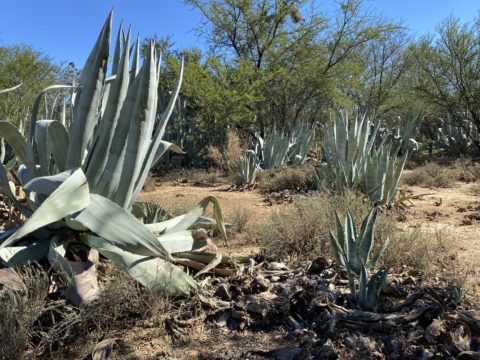
An agave mother (left) with two babies (right). (Photo: Leah van Deventer)

Signs that a porcupine nibbled on the leaf. (Photo: Leah van Deventer)
The flowers – of the plants not destined for agave spirits – are also highly nutritious.
“If you take a panga now, and chop this pole three or four times, you’ll see the kudu will suddenly appear, because they know the pole is going to fall and there are going to be [flowers] on the ground.”
Finally, in the 1990s, another opportunity arose in the shape of an agave shortage in Mexico, the motherland for agave spirits. This caught the attention of an ambitious man by the name of Harvey Venter, who saw a window of opportunity to challenge the country’s monopoly on agave spirits.
Venter’s vision was contagious; he managed to both hustle some R15-million on the venture-capital market and persuade the local farmers to reinvigorate their plantations, peddling promises of great riches.
And so, in 1997, Tequila and Mezcal Distillers Ltd was born, a rather enormous operation based just down the drag from Murray’s farm. Not surprisingly, this alarmed the Mexican spirit producers, who were not only threatened by the competition but objected to the name.
“The Mexicans just about had a fit, because, quite rightly, they disagreed with a South African company using the name. We had numerous visits from Mexico and even some threats,” recalls Murray.
“Pretty soon after that, we discovered we had the agave weevil, and we’d never known the agave weevil before. One of their threats was that they’d scupper our attempt, you know? But there are two possibilities of the weevil’s arrival. The other one is that the farmers had a tiff with the factory about the prices. So the factory then imported some Agave sisalana from Natal [as opposed to the Agave americana of Graaff-Reinet] and possibly the weevil came with.”

Agave weevils. (Photo: Leah van Deventer)
The next hurdle for Reinet Distillers (as it was now called) was the equipment, which had been damaged at sea, en route from Portugal. An argument ensued about payment, and so instead of assisting with the still’s set up, the technicians who’d accompanied it up and left.
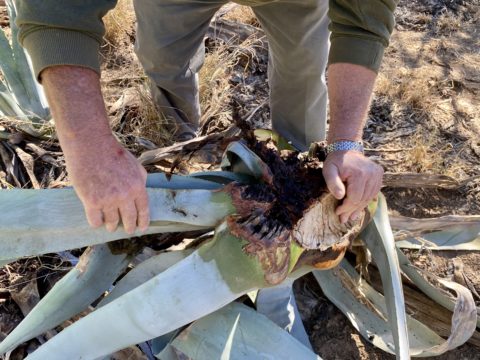
Tim Murray showing the damage done by agave weevils. (Photo: Leah van Deventer)
“Management decided that they’d finish completion of the factory by themselves. They put the still up, but it didn’t fit in the building, so they cut a hole in the roof. If you drive past, you’ll see a little pimple on the roof. They really struggled with that still. Then, without distilling one drop of alcohol, they went bankrupt,” Murray laughs, darkly.
Reluctant to forsake his outlay, Keith McLachlan, one of the investors, purchased Reinet Distillers in 2000, renaming it Agave Distillers. He abandoned the treacherous column still, and got production going with potstills instead.
“They managed to make a reasonable product [called Agava], and they were in the market. But then they were out of the market. Then 9/11 happened, and ja, ag, all kinds of things went wrong. Finally they employed somebody who knew a little bit about what was going on, and this guy walked in and said, ‘Um, excuse me, but why is this still upside down?’,” Murray recollects.
When they put it the right way round it fitted in the building … But by then they were far down the track, and went bang,” he ends.
Evidently, McLachlan was booted from the board in 2006 – having failed to “take agave to the next level” – and replaced as CEO by Jan Terblanche. Agave Distillers was liquidated in 2008, following Terblanche’s death.
“Finally, after nearly 12 years, the company was wound up in an estate, which was the end of the business. It was then put on auction and various companies bought all the equipment. The local road builder bought the building, and here we sat. I’d planted about 40 hectares…” laments Murray.
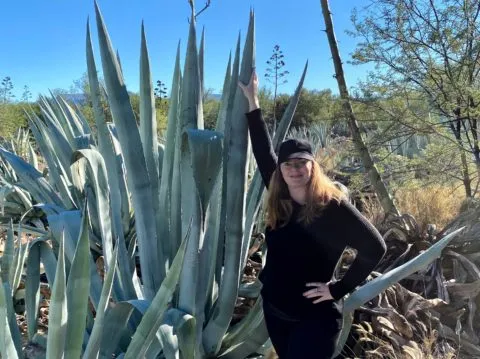
The author (162cm) standing next to one of the agaves Tim Murray planted 22 years ago. (Photo: Wendy van Heerden)
Despite this tale of woe, the dream of agave spirits didn’t die along with the troublesome distillery outside Graaff-Reinet.
In 2016, Leigh Lisk and Lucy Beard released Esperanza Agave, an addition to their thriving gin portfolio at Hope Distillery. Although they used local agave initially, since 2019 they’ve been importing Blue Weber Agave from Mexico.
Shortly afterwards, in 2017, Sarah Kennan launched Leonista Agave Spirit, which is made from Murray’s agave and distilled by Schoonspruit Distillers in Ventersdorp. I’ve met Kennan many times, and have to wonder if her success can be linked to her adage that agave spirit must be consumed with respect.
Then in 2018, winemaker Adi Badenhorst – of Caperitif acclaim – started distilling 4th Rabbit on behalf of Signal Hill Products, also with Murray’s plants. I recall that when I visited his farm that year, he told me just how hard it was, compared to anything else he’d ever done.
Around 2019, father and son team Maarten and Nic van Doesburgh added Agava to their range of beers and other spirits at Plebs Brewing Company, having bought the brand name from the fated Agave Distillers.
Finally, Murray himself has also joined the fray.
His brand is named Three Agaves, after the first three little plants responsible for the genesis of agave in the Karoo. Like Leonista, Three Agaves is produced at Schoonspruit.
In Murray’s opinion, Agave Distillers failed simply because they went too big, too quick. He also believes most craft products are over packaged, while underperforming.
“I want to do it the opposite way. You can only buy it here [in Graaff-Reinet]. I don’t do any marketing and I use the cheapest packaging, so that I can cut my price. I come into the market at about R100 cheaper than everyone else. From that point of view, it’s a very interesting product, but obviously, I am not going to get rich,” he laughs dryly.
“I’m almost certain that anyone else that’s doing it has almost never made a profit. I’ve never made a loss. I can’t make a loss because I don’t have the cost structure to make a loss, whereas every other brand has gotten a bloody nose at some stage,” he continues.
As outlined before, it’s also incredibly technically demanding, requiring skills unlike those of other spirits.
“The trick is the fermentation, in my opinion, because it is a long-chain sugar, inulin. It doesn’t ferment with simple alcohol yeasts. You need special yeasts, and of course the Mexicans are experts at it. They’re born with the yeast under their fingernails, I think, so they just have to bless it by washing their hands, and off they go.”
That doesn’t stop the siren’s song from luring postulants to the Karoo, however.
“Let me tell you, others are trying. I have a phone call or an email every single week. Distilleries from the West Coast to Ballito. They come here, and they go home with a piña on the back of their car … Then, it doesn’t work.”
Murray lives in hope, however, that our agave spirits industry will one day prosper. In fact, he’s willing to offer buildings on his farm to anyone brave enough to come set up a distillery.
When he said that, I swear I heard a melody, and felt compelled to head home, pack the cats and move to the Karoo myself.
In the meantime, the wildlife feast. DM/TGIFood
For more boozy news, catch Leah on Twitter or Instagram.





 Become an Insider
Become an Insider
Beautiful story